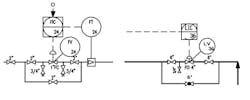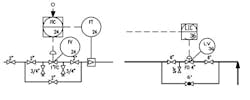Open Up More Capacity
Squeezing the last bit of capacity from a chemical plant often provides much of the profit for the facility. After all, fixed costs from equipment maintenance and depreciation vary little with flow rates but extra throughput, if salable, adds directly to profit. When seeking to achieve extra flow, you can learn a lot from plant operators. When being pushed for capacity, they think about the control valve bypasses.
[pullquote]
A control valve bypass gets installed to allow maintenance on the control valve without forcing the plant to shut down.
Every control valve imposes a variable pressure drop to modulate flow. A lower pressure drop enables higher flow rates. The exact relationship of valve opening to flow rate depends upon the valve trim (e.g., quick opening, linear, modified parabolic or equal percentage). Any valve type provides its maximum flow rate when fully open. Getting more flow requires reducing the overall flow resistance of a system. One way to achieve this is by opening the bypass line.
Figure 1. The two lines use different types of valves —gate (left) and globe (right) — which affects cost and controllability.
Plants have different philosophies about using open bypasses during normal operations. Some sites absolutely prohibit the practice. Others allow it without much ado. Most plants’ viewpoint fall somewhere in the middle — as does mine.
Why prohibit using the bypass? The logic here is that the bypass only is installed for maintenance purposes — therefore, it should be used just for that. An open bypass is an “exceptional” situation. Because the operators are not used to the bypass being open, it creates an unacceptable hazard.
The contrasting view is that plants have lots of pipes without valves in them — so, keeping the bypass open isn’t a big deal. Open lines always provide the highest flow rate for the available pressure drop.
In the middle lies the thought that having a permanently open bypass isn’t necessarily a big problem — but it represents a change that the plant must recognize, e.g., by re-evaluating safety contingencies for the normal condition of an open bypass. The middle ground takes the position that with proper management of change (MOC) for operating procedures, safety analysis and training to ensure everyone knows the new operating conditions, it might be okay to leave a bypass in the open position.
You should follow formal MOC procedures in evaluating any permanently open bypass. Even though opening the bypass may seem a minor change to plant operations, it often requires complex analysis for confidence in the results. Besides affecting normal procedures, an open bypass may mandate changes to upset and shutdown protocols.
Figure 1 shows two options for a control valve bypass. The bypass on the left uses a gate valve while the one on the right relies on a globe valve. Normal practice is to install a gate valve for isolating a control valve for maintenance. The gate is either fully closed or fully open. Using a partially open gate valve for flow control can pose difficulties. Flow rate may not change smoothly with valve position. Additionally, high velocities through a partially open gate valve may cause significant valve erosion. Once eroded, the valve may not fully seal again.
In contrast, a globe valve has a body similar to that of a control valve — but with a manually turned stem — and so will give a good control response of flow rate versus valve position. It also tends to avoid problems with valve and seat damage when used partially open. However, a globe valve is much more expensive than the same diameter gate valve.
Consider a globe valve for a bypass that will handle flow during normal operation or whenever additional capacity is needed, to allow finer control of the flow.
Regardless of the type of valve used, safety and operating procedures must take the open bypass into account.
ANDREW SLOLEY is a Chemical Processing Contributing Editor. You can email him at [email protected].

